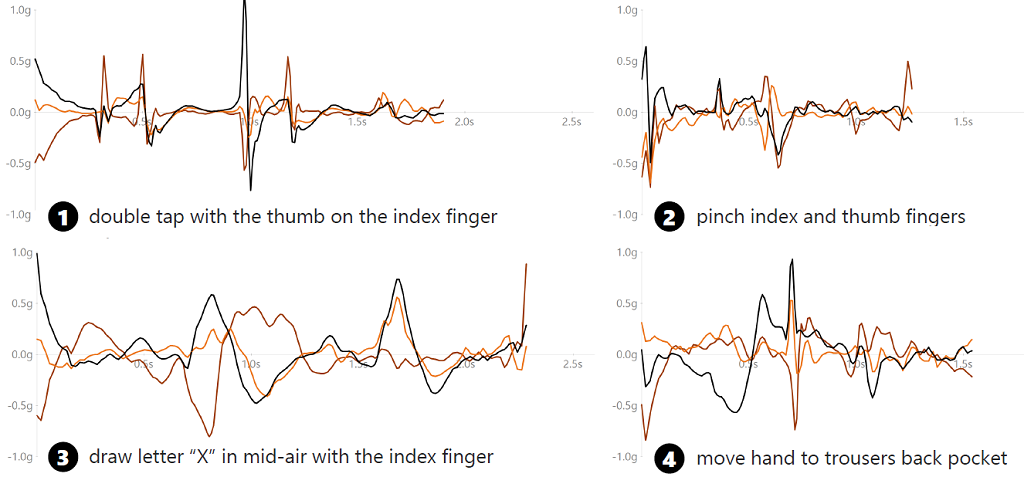DATASET ID# 2023-GESTURES-IFAD
A dataset is provided with 6,369 gestures of 40 distinct types,
collected from 20 participants using a custom-made
index-Finger Augmentation Device (iFAD). The dataset represents a companion resource
for (Vatavu, 2023), where iFAD gestures were examined in detail
with a dedicated taxonomy and a user study addressing various aspects of user performance and perception.
The dataset includes gestures of diverse complexity, from simple taps
on the iFAD to specific finger and hand poses, stroke-gesture articulations
of geometrical shapes, letters, and symbols in mid-air, and body-referenced
gestures. A few examples are provided below:

iFAD Gesture Taxonomy
The gesture types included in the dataset were selected according to the following taxonomy of iFAD gestures, see (Vatavu, 2023) for details:
Resources
We release our gesture dataset to encourage further work on
finger-augmentation devices designed to be worn on the index finger, i.e., iFADs.
Our gesture dataset and C# code and
the gesture ratings data are
freely available to download and use for research purposes under
this license .
Following the four categories of this taxonomy, the dataset includes 40 gesture types, as follows:
-
10 gestures performed at finger level:
- Tap: perform a tap on the iFAD
- Double tap: tap the iFAD twice
- Back tap:perform a tap on the back of the iFAD with palm upward
- Double back tap: tap the iFAD twice on the back with palm upward
- Twist left: slightly rotate the iFAD to the left and rotate back
- Twist right: slightly rotate the iFAD to the right and rotate back
- Twist left-right: slightly rotate the iFAD to the left, right, and then back
- Twist right-left: slightly rotate the iFAD to the right, left, and then back
- Pull: slightly pull the iFAD along the finger and bring it back
- Pull twice: perform the "Pull" gesture two times in a row
-
10 gestures performed at hand level:
- Fist: make the closed fist hand pose
- Vertical palm: hold palm vertically with all fingers fully stretched
- Horizontal palm: hold palm horizontally with all fingers fully stretched
- Lateral palm: hold palm to the right of the body with fingers stretched
- Pinch: touch the thumb and index fingers
- Pinch twice: perform the "Pinch" gesture two times in a row
- Shake: shake the hand wearing the iFAD
- Shake twice: perform the "Shake" gesture two times in a row
- Knob rotate left: hand rotates imaginary control knob in mid-air to the left
- Knob rotate right: hand rotates imaginary control knob in mid-air to the right
-
10 gestures performed at arm level:
- Circle: draw a circle in the vertical plane in front of the body
- Square: draw a square in mid-air
- Heart: draw a heart shape in mid-air
- Letter "X": draw letter "X" in mid-air
- Letter "M": draw letter "M" in mid-air
- Letter "S": draw letter "S" in mid-air
- Check: draw the "check" symbol in mid-air
- Question mark: draw the "question mark" symbol in mid-air
- Swipe left: quick movement of the hand wearing the iFAD to the left
- Swipe right: quick movement of the hand wearing the iFAD to the right
-
10 body-referenced gestures:
- Left ear: bring the hand wearing the iFAD to the left ear
- Right ear: bring the hand wearing the iFAD to the right ear
- Mouth: bring the hand wearing the iFAD to the mouth
- Elbow: bring the hand wearing the iFAD to the elbow of the other arm
- Back neck: bring the hand wearing the iFAD to the back of the neck
- Trousers front pocket: put the hand wearing the iFAD in the trousers front pocket
- Trousers back pocket: put the hand wearing the iFAD in the trousers back pocket
- Shirt pocket left: bring the hand wearing the iFAD to the left shirt pocket
- Shirt pocket right: bring the hand wearing the iFAD to the right shirt pocket
- Join hands: join the two hands in front of the body
If you find our dataset and/or code useful in your work, please let us know.
If you use our dataset and/or code in scientific publications, please reference the paper (Vatavu, 2023) that introduced these resources.
Publication
The following Supplementary Material presents calculation details about
the complexity of the iFAD gestures from our dataset.